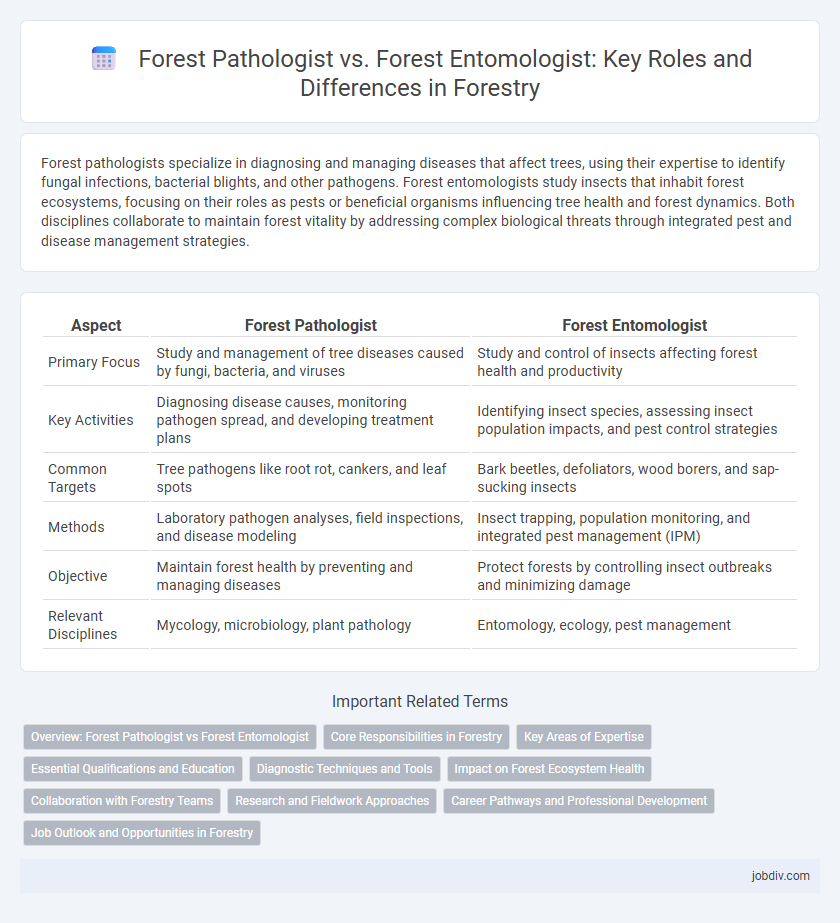Forest pathologists specialize in diagnosing and managing diseases that affect trees, using their expertise to identify fungal infections, bacterial blights, and other pathogens. Forest entomologists study insects that inhabit forest ecosystems, focusing on their roles as pests or beneficial organisms influencing tree health and forest dynamics. Both disciplines collaborate to maintain forest vitality by addressing complex biological threats through integrated pest and disease management strategies.
Table of Comparison
| Aspect | Forest Pathologist | Forest Entomologist |
|---|---|---|
| Primary Focus | Study and management of tree diseases caused by fungi, bacteria, and viruses | Study and control of insects affecting forest health and productivity |
| Key Activities | Diagnosing disease causes, monitoring pathogen spread, and developing treatment plans | Identifying insect species, assessing insect population impacts, and pest control strategies |
| Common Targets | Tree pathogens like root rot, cankers, and leaf spots | Bark beetles, defoliators, wood borers, and sap-sucking insects |
| Methods | Laboratory pathogen analyses, field inspections, and disease modeling | Insect trapping, population monitoring, and integrated pest management (IPM) |
| Objective | Maintain forest health by preventing and managing diseases | Protect forests by controlling insect outbreaks and minimizing damage |
| Relevant Disciplines | Mycology, microbiology, plant pathology | Entomology, ecology, pest management |
Overview: Forest Pathologist vs Forest Entomologist
Forest pathologists specialize in diagnosing and managing diseases caused by fungi, bacteria, and viruses that affect tree health, focusing on pathogen identification and disease control strategies. Forest entomologists study insect populations that impact forests, analyzing insect behavior, ecology, and their role in tree damage or forest ecosystem dynamics. Both fields collaborate closely in forest management to address biotic stress factors and maintain forest vitality.
Core Responsibilities in Forestry
Forest pathologists specialize in diagnosing and managing diseases affecting trees and forest ecosystems by identifying fungal, bacterial, and viral pathogens. Forest entomologists focus on studying insect species that impact forest health, including pest behavior, life cycles, and control methods to prevent damage. Both professionals play critical roles in maintaining forest vitality through monitoring, research, and implementing pest and disease management strategies.
Key Areas of Expertise
Forest pathologists specialize in diagnosing and managing tree diseases caused by fungi, bacteria, viruses, and environmental stressors, directly impacting forest health and timber quality. Forest entomologists focus on the study of insects that affect forest ecosystems, including pest identification, life cycles, and control methods to prevent extensive damage. Both experts collaborate on integrated pest and disease management strategies to sustain forest productivity and biodiversity.
Essential Qualifications and Education
Forest pathologists typically require a bachelor's degree in forestry, plant pathology, or biological sciences, often followed by a master's or Ph.D. specializing in tree diseases and fungal pathogens. Forest entomologists usually hold degrees in entomology, forestry, or ecology, with advanced studies emphasizing insect behavior, pest management, and forest ecosystems. Both professions benefit from strong backgrounds in field research, laboratory skills, and knowledge of forest health monitoring techniques.
Diagnostic Techniques and Tools
Forest pathologists utilize diagnostic tools such as microscopy, molecular assays like PCR, and cultural isolation techniques to detect fungal pathogens and assess disease progression in trees. Forest entomologists rely on trapping devices, pheromone lures, and insect identification keys, combined with microscopic examination, to diagnose insect infestations and monitor pest populations. Both specialists employ remote sensing technologies and field surveys to complement laboratory diagnostics and enhance accuracy in forest health assessments.
Impact on Forest Ecosystem Health
Forest pathologists specialize in diagnosing and managing diseases caused by fungi, bacteria, and viruses that severely affect tree vitality and forest productivity. Forest entomologists study insect populations that can defoliate trees, transmit pathogens, and disrupt nutrient cycling, leading to widespread ecological imbalance. Both roles are critical in monitoring and mitigating biotic stressors that threaten forest ecosystem health and sustainability.
Collaboration with Forestry Teams
Forest pathologists and forest entomologists collaborate closely with forestry teams to identify and manage biotic threats such as fungal diseases and insect infestations that affect tree health and forest ecosystems. Their combined expertise enables the development of integrated pest management strategies that protect timber resources and promote forest resilience. Effective communication between these specialists and forestry professionals ensures timely interventions and sustainable forest management practices.
Research and Fieldwork Approaches
Forest pathologists specialize in studying tree diseases caused by fungi, bacteria, and viruses, employing laboratory analysis and field sampling to identify pathogens and assess tree health. Forest entomologists focus on insect species impacting forest ecosystems, using trapping, population monitoring, and behavioral observation to understand pest dynamics and their effects on forest vitality. Both disciplines integrate ecological modeling and remote sensing techniques to inform forest management and conservation strategies.
Career Pathways and Professional Development
Forest pathologists specialize in diagnosing and managing tree diseases caused by fungi, bacteria, and viruses, with career pathways often including research positions, government forestry agencies, and environmental consulting firms. Forest entomologists focus on studying insects that affect forest ecosystems, pursuing roles in pest management, ecological research, and forest health monitoring within academic institutions, government bodies, or industry. Both career paths emphasize continuous professional development through advanced degrees, certification programs, and participation in professional organizations like the Society of American Foresters and the Entomological Society of America.
Job Outlook and Opportunities in Forestry
Forest pathologists and forest entomologists both play vital roles in forestry by managing tree health; forest pathologists focus on diagnosing and controlling diseases, while forest entomologists specialize in understanding insect pests affecting forests. The job outlook for both professions is positive due to increasing concerns over forest conservation, pest outbreaks, and climate change impacts, with opportunities available in government agencies, research institutions, and environmental consulting firms. Demand for expertise in integrated pest management, forest restoration, and ecosystem health supports steady career growth in these specialized forestry fields.
Forest Pathologist vs Forest Entomologist Infographic

 jobdiv.com
jobdiv.com